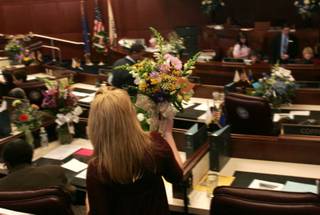Tuesday, Feb. 3, 2009 | 2 a.m.
Sun Special Coverage
Sun Archives
- What the stimulus plan would mean for Nevada (1-29-2009)
- Medicaid cuts compound health, economic crises (12-2-2008)
- Kids’ health care ailing (5-13-2003)
Congress approved more federal spending to expand the Children’s Health Insurance Program and lawmakers in Carson City say they will defeat the governor’s proposal to cap the number of children who can participate in the state’s program.
But experts say all of that will do Nevada little good if the state doesn’t start spending more of its own money in the program.
The state’s historical tendency to appropriate little money for Nevada Check Up has forced the program to leave behind millions of dollars in unmatched federal funds in the past decade.
“In Nevada, the issue has never been a lack of federal funds,” said Jon Sasser, advocacy chairman for the Nevada Covering Kids and Families Coalition. “It has been the lack of participation by the state” in Nevada Check Up, said Sasser, who has lobbied the Legislature on the issue for a decade.
The chronic shortfall in state support for the program has left it serving only a third to one-half of those eligible for help, according to Chuck Duarte, the state employee who oversees Nevada Check Up. The gap in the program’s state funding “is the elephant in the room,” he said.
If the Legislature, in the session that began Monday, doesn’t significantly increase Nevada’s contribution, tens of thousands of families lacking health insurance for their children will likely remain uninsured.
The problem comes from “our libertarian view that you should be able to take care of yourself,” said Assemblywoman Sheila Leslie, D-Reno, chairwoman of the budget subcommittee that oversees the program.
“But that’s unrealistic when it comes to health insurance,” Leslie said. The lawmaker said she will be fighting, first, to lift the proposed cap and, second, to end Nevada Check Up’s chronic shortage of funding.
Edwin Park, senior fellow at the Washington-based Center on Budget and Policy Priorities, said Nevada over time has developed one of the widest gaps between what the federal government could give the state for the program and what the state receives.
“It’s an unusual situation,” he said. “Nevada’s funding has always been much less than the federal funding.”
For example, in the fiscal year ended Sept. 30, Washington allocated $51 million to Nevada Check Up, but the program got only $28.8 million of that, Park said. That’s because the state’s contribution — $14.2 million — fell short.
To get all $51 million from the feds, Nevada would have had to contribute $11 million more than it did. If it had, Nevada Check Up would have had a total of $75 million, instead of $43 million.
Those figures don’t even take into account left-over untouched money from previous years, which can be used for up to three years under current regulations. In 2008, $90 million more was left on the table.
That money could have gone to insuring children in families with incomes of $21,200 to $42,400 a year. Currently, the program serves nearly 25,000 children, but Duarte estimates as many as 75,000 children in the state are eligible.
Sasser notes Nevada Check Up had about 30,000 children enrolled only a year ago, but budget shortfalls led the state to put less money into outreach. As people fell off the rolls, and staff fell behind in answering applications, the caseload dropped.
But that is not a reflection of true need, he said. To reverse the current situation, not only must the state abandon the idea of capping enrollment at current levels, it must also increase staff and outreach, by increasing state and matching federal funding.
Duarte said he hopes the federal economic stimulus package allows the state to pull money from other programs, such as Medicaid, and dedicate those dollars to Nevada Check Up.
But Sasser is not so sure the state is ready to reverse its historic tendency to give short shrift to the idea of insuring children in low-to-middle-income families.
He said reaching last year’s levels may be the best the state will achieve, particularly given budgetary concerns.
That would be unfortunate, said Patricia Durbin, executive director of the Great Basin Primary Care Association, a group that advocates affordable health care.
She says more children will wind up in emergency rooms seeking help with conditions that could have been avoided with affordable primary care. That will cost the community more.
Increasingly, these will be the children of families that once had insurance and lost it along with their jobs.
“In the past, this was seen as poor people’s insurance,” Duarte said. “But that’s no longer the case.”


Join the Discussion:
Check this out for a full explanation of our conversion to the LiveFyre commenting system and instructions on how to sign up for an account.
Full comments policy